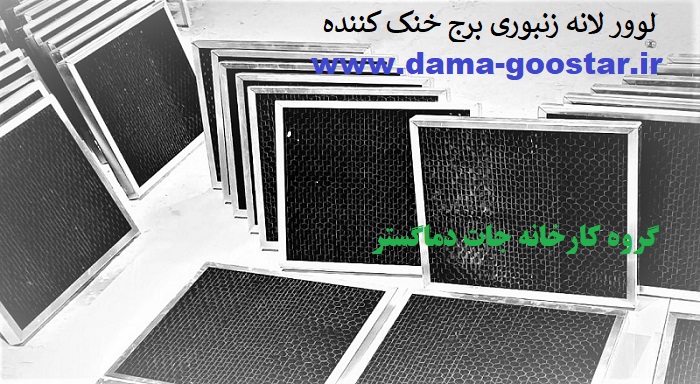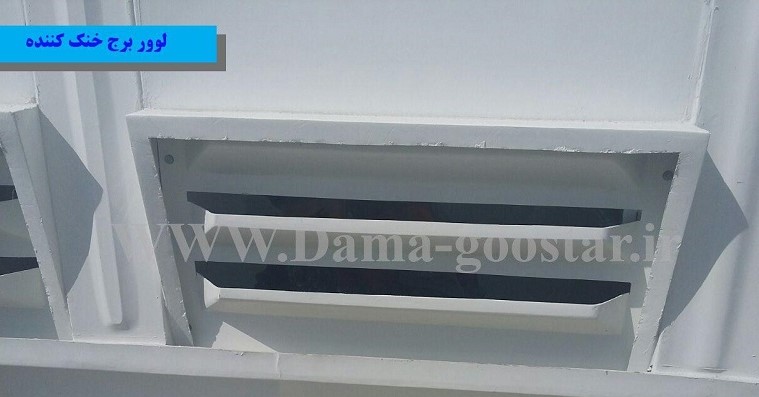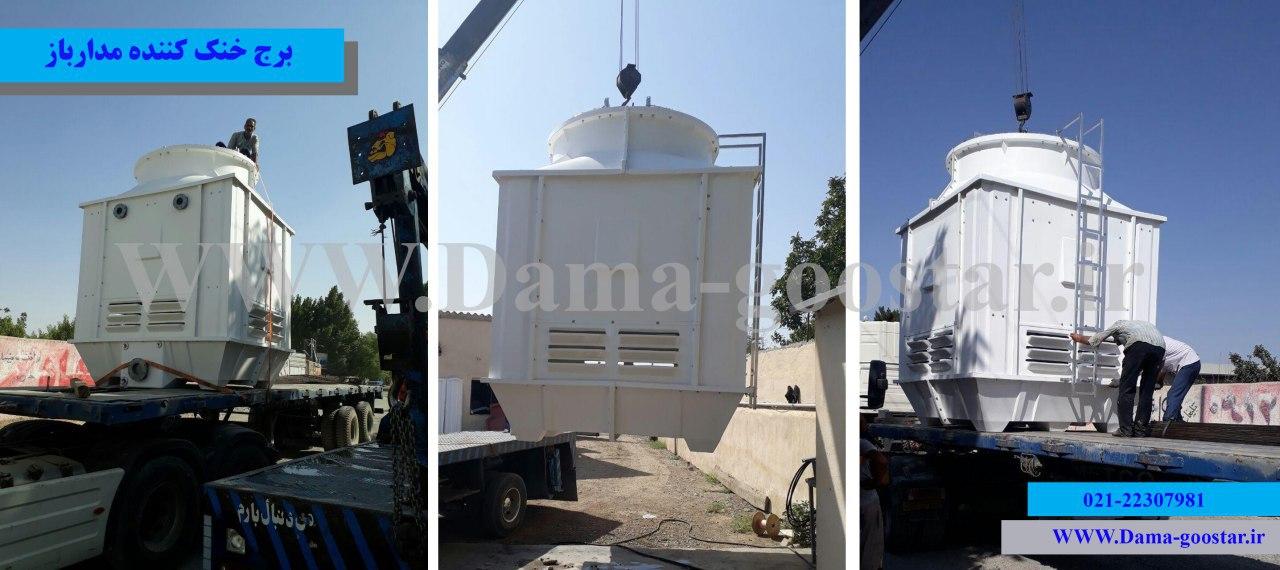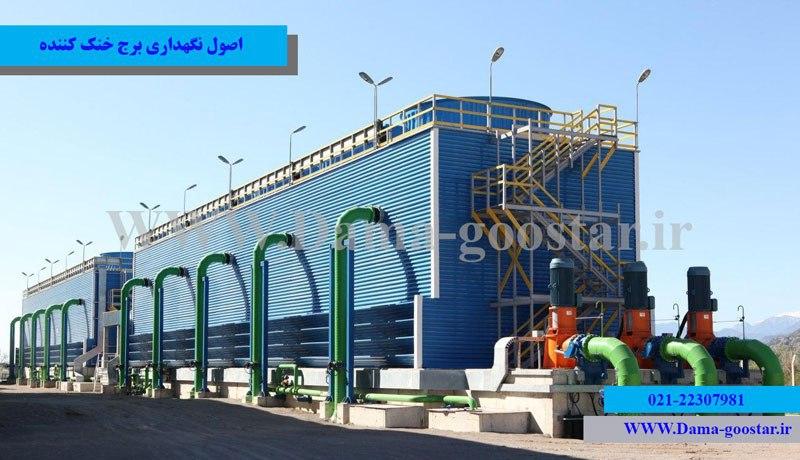
Industrial cooling tower is a producer of cold water in industry and a source of cooling for industrial equipment. This model of cooling tower is also called cooling tower for industrial use. In this type of use of water cooling source, the purpose is to cool large devices. In industry, most equipment requires constant ventilation and cooling for permanent operation. In order to stabilize and stabilize the temperature of these machines, a cooling tower is used. Cooling tower is more used in industrial devices, especially in heating equipment, than in the field of cooling of air conditioning systems (chiller cooling tower) .
The main use of cooling towers is to adjust the temperature of heat sources and heavy machinery such as boilers, injection machines and induction furnaces. An induction furnace requires the transfer of additional heat generated to the outside environment after a melting process. The air around the furnace naturally cannot dissipate large volumes of this heat energy to the outside environment. The water fluid with a very high specific heat capacity achieves this goal and after receiving heat returns to the cooling tower for recovery. In plastic injection systems, the mold must be cooled within a certain time during a plastic injection process. Cooling of the mold is done by industrial cooling tower or water cooling chiller.
A simple and conceptual example of the use of a cooling tower in industry:
Cooling tower = industry thermal waste bin
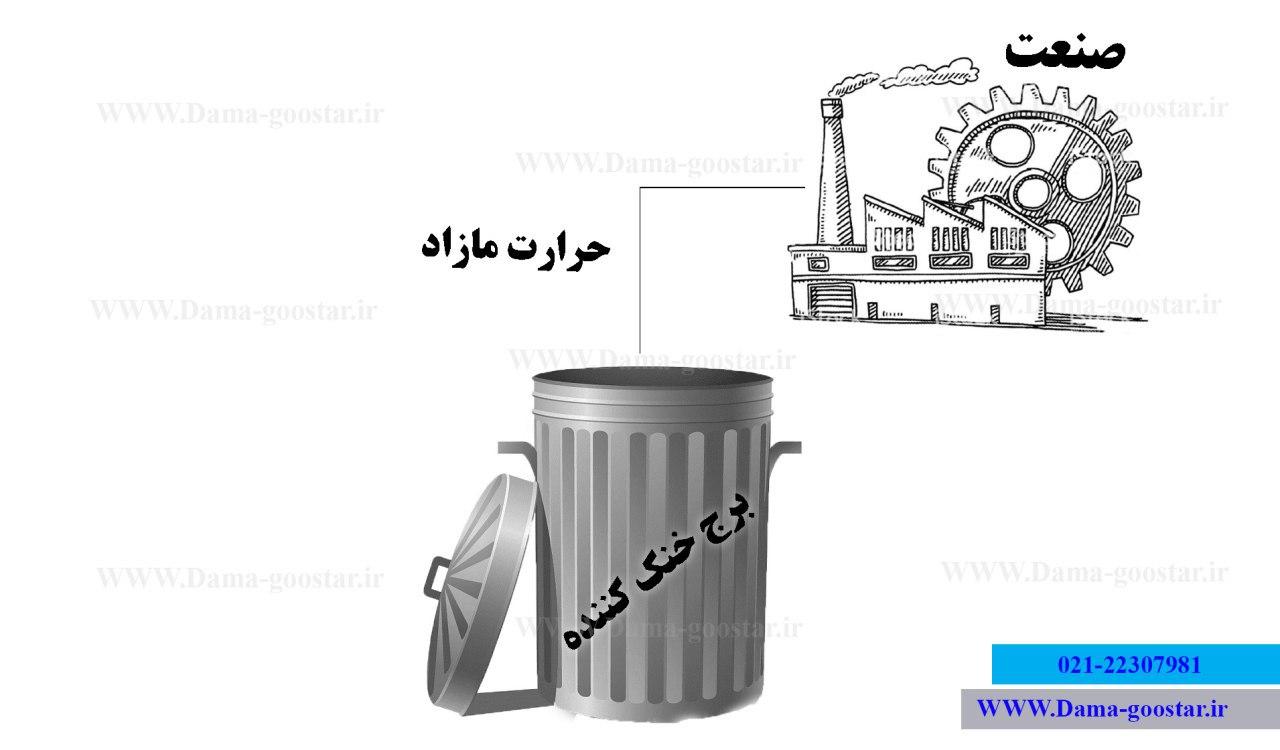
What is the unique property of water in cooling industrial equipment?
Water is a unique fluid in the sciences of heat transfer and fluids. The main reason for the special nature of water fluid in cooling and refrigeration systems is the high specific heating capacity of this fluid in heat absorption. The specific heating capacity of a fluid is in fact its potential for absorbing and dissipating heating energy. Water is the best possible option for cooling industrial equipment due to having the highest heating capacity in fluids. Water needs to be regenerated by absorbing large amounts of heat from industrial machinery. Reset the water temperature and reduce it to the standard level in the cooling tower.
Important Note: Despite the special high heating capacity of water, in some cases oil is used to absorb heat !!
Other fluids, such as oil, are widely used in the refrigeration and defrosting of some equipment. The reason for using oil in the fluid circulation system to dissipate heat from industrial engines is not only because of this issue. In addition to heat absorption in industrial engines, the oil fluid is responsible for reducing the amount of friction between parts and bearings.
Generally, in systems that use oil circulation to lubricate the engine, etc., water is also used to dissipate oil heat to the environment. In this case, the water by circulating in a heat exchanger transfers the oil heat to the outside environment through the cooling tower.
Types of cooling tower applications in industry
Pneumatic plastic injection machine cooling
For cooling oily plastic injection machine
Adjusting the temperature of the induction furnace in the process of melting metals
Permanent temperature adjustment of water or absorption chillers (in all large factories with central ventilation)
Adjusting the temperature of hydraulic oil in industrial gearboxes (in all heavy and machine industries)
Cooling of hydraulic oil in shell and tube heat exchangers by cold water (like hydraulic press machine)
Reducing the temperature of thermal oils such as trans oils (different parts of non-ferrous metals reduction industries)
Reducing the temperature of hot air produced in air compressors (power generating plants)
Adjustment of sulfuric acid temperature in stainless steel converters (anti-acid) after dilution process (battery factory)
Use of industrial cooling tower in plastic injection
This industry is in fact one of the most important industries for the production of plastic and polymer parts in the country and even in the world. Plastic injection machines in both air and oil types perform the process of injecting granular materials into special molds. The main task of the cooling tower in the plastic injection industry is to cool the mold for injecting materials by water.
Why does the plastics injection industry need a cooling tower?
In answer to this question, it should be stated that when the granular material enters this equipment in the hopper part, after heating to a very high temperature, it enters the mold part for molding. Well, naturally, the cooling of the molten granular material in the form requires heat dissipation to the outside environment, which is the responsibility of the cooling tower of the injection device.
All plastic injection machines have an inlet and outlet with a specified size for water circulation in the cooling tower circuit. Of course, in some cases, the injection machine has two inlets and outlets of water (one to cool the mold and the other to cool the oil), which is called the injection of oily plastic.
How can the capacity of the cooling tower required in plastic injection circulating systems be estimated?
The cooling capacity of the cooling tower in the plastic injection industry is estimated depending on the size of the inlet and outlet connections and the type of plastic injection machine. Based on the size of the mold and oil cycle cooling connections in the injection machine, the amount of water circulation required to cool this machine can be easily calculated. The manufacturer easily calculated the injection device.
Cooling tower in oil and petrochemical industry (refineries)
In a crude oil or fuel oil refinery, the goal is to cool the oil in the distillation tower to lower temperatures in a step-by-step manner (step by step). The temperature of crude oil sometimes rises even above 400 ° C, in which case water is used to cool the oil in the distillation tower. The cooling water required in the distillation tower is supplied by the cooling tower or cooling tower.
What is the reason for the increasing use of cooling towers in the petrochemical industry?
Due to the increasing production of oil and gas in the country, today the oil and petrochemical industry needs more cold water systems. On the other hand, cooling water consumption, sediment and severe clogging in these industries was a major problem. Due to the advancement of science and technology today, Damagostar Company is proud to present a new generation of cooling tower called low consumption hybrid cooling tower and has been able to make a great contribution to the oil and petrochemical industry during the cooling cycle of distillation towers.
Cooling tower in metal smelting industry
Iran is one of the largest producers of metal industries and metal smelting in the world. Increasing the consumption of iron equipment increases sales and thus increases the percentage of melting in furnaces of metal smelting industries. Metal smelting industry in its induction furnaces sector needs water cooling systems. The task of cooling and reducing the temperature of the induction furnace during melting is the responsibility of the cooling tower.
In simpler terms, the cooling water cooling tower required in the main water circulation cycle of the induction furnace (plant) and the capacitor bank provides the DC link and the control panel. Generally, CCTV cooling tower is used in this refrigeration cycle to reduce water consumption costs and also to prevent sediment and clogging.
Is the main reason for the decrease in melting rate of the induction furnace cooling tower?
The answer to this question is yes. Non-observance of design principles in the water circulation system in the induction furnace is the main reason for this. The calculation of the cooling capacity of the cooling tower in the cold water circulation circuits in an induction furnace should be based on 100% of the melting rate. Today, unfortunately, due to lack of technical knowledge, most metal smelting and rolling companies use a maximum of 60% of furnace power for smelting.
What is the main reason for alarms in induction furnaces? What does this alarm have to do with the cooling tower?
The low capacity of the cooling system in the cooling cycle of the induction furnace increases the temperature of the furnace. The induction furnace temperature alarm system in industry is generally set between 35 and 45 ° C. Now, if the cooling tower does not have the ability to dissipate heat from this equipment (furnace) or in other words, the cooling power of the cooling tower is less than the heating capacity of the furnace, the furnace temperature will increase over time and cause alarm in the system.
A common proverb among cooling tower manufacturers about metal smelting companies: No matter how much you buy a smelting tower.
"Our pride in the cooling tower"
Cooperation with Qeshm smelting and zinc companies, Zanjan zinc explorers, Kabkan steel, Tabadakan steel, Etihad steel machine building (Qazvin)
Brys Steel, Natanz Steel, Isfahan Steel
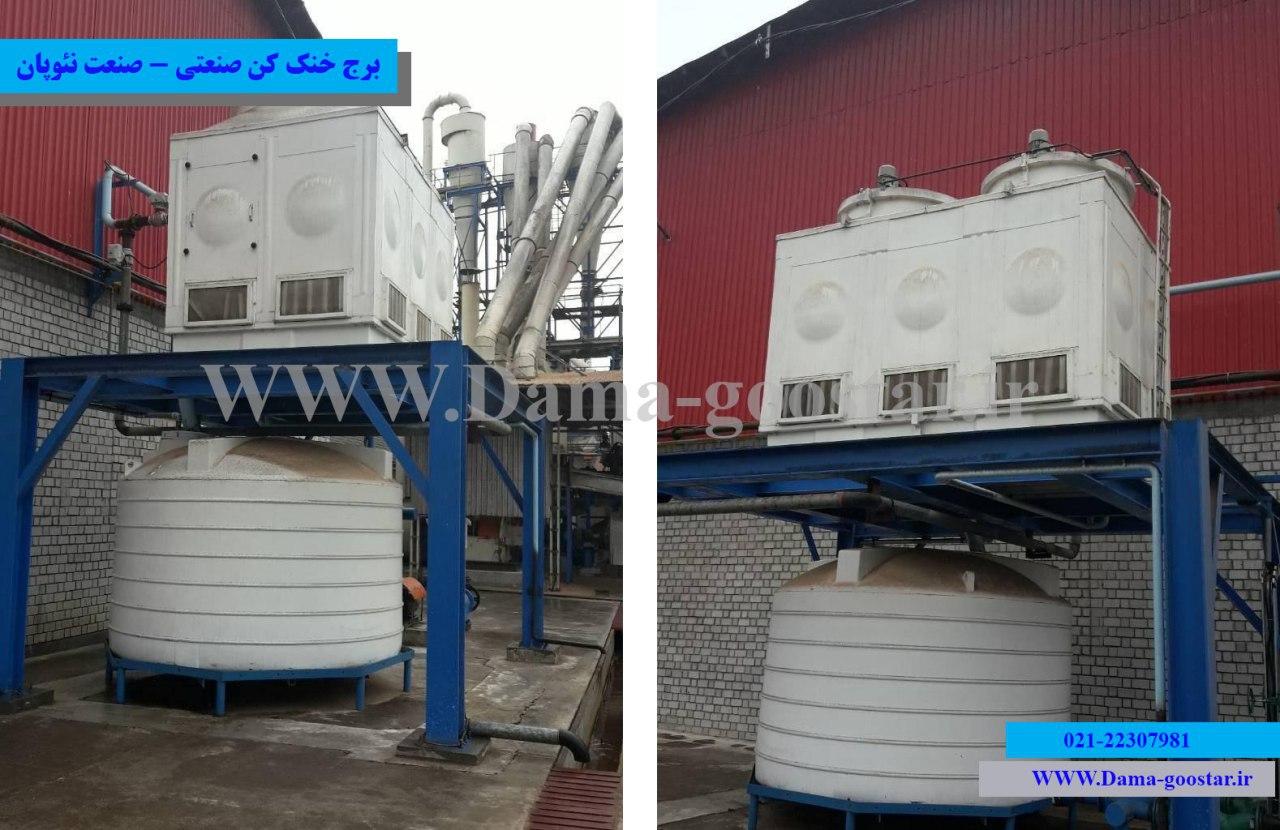
Application of cooling tower in wood industry (chipboard)
The use of cooling towers in the cooling of the chipboard industry may be a little unbelievable. Adhesive is one of the most important materials used in the production of chipboard. This adhesive is subjected to a sharp rise in temperature during a chemical treatment, which is the most important task of the cooling tower in the chipboard industry. Generally, the estimated capacity of a cooling tower in this industry depends on the amount of adhesive produced and the size of the coil connections around the furnace.
Application of cooling tower in metal forming industry
The industry of forming metals and polymer materials includes extruders and die-casting machines. This equipment basically has a certain number of inlets and outlets of water circulation in its condenser. Depending on the production capacity of various parts such as hose pipes, copper filaments and other output products of these devices, the water circulation capacity and as a result the cooling capacity of the cooling tower are calculated.
Application of industrial cooling towers in power plants
The cooling tower is used in this application in very large capacities in the industry of power plants, solar power plants, nuclear power plants and combined cycle power plants. The purpose of the cooling tower in steam power plants is to cool the steam output of gas turbines. Due to the widespread use of steam power plants and the frequent use of gas and steam turbines in the equipment cycle of this industry, water cooling systems are of great importance. Most of the country's power plants use cylindrical cement cooling towers to cool their circulation system. High water consumption of this type of industrial cooler is in fact one of the biggest problems of this equipment that today dry and combined cooling tower has replaced this model of refrigeration sources.

Application of industrial cooling tower in cement industry
Cement production industry has faced significant progress today due to the current need of construction structures for this material. The use of cooling towers in the cement industry is important for cooling water before the concrete mixing process. In the past, ice mixing was used in cement production and ready-mixed concrete. Lack of economic justification in this sector due to the high cost of buying ice led to the widespread use of cooling towers in this industry.
In addition to the above application, the industrial cooling tower is also used to cool the circulating water cycle in the mixer in the cement industry. Today, in most cement factories such as Lamerd Cement, Ahvaz Cement, Portland Cement and other cement industries, the cooling tower produced by Damagostar Company is used.

